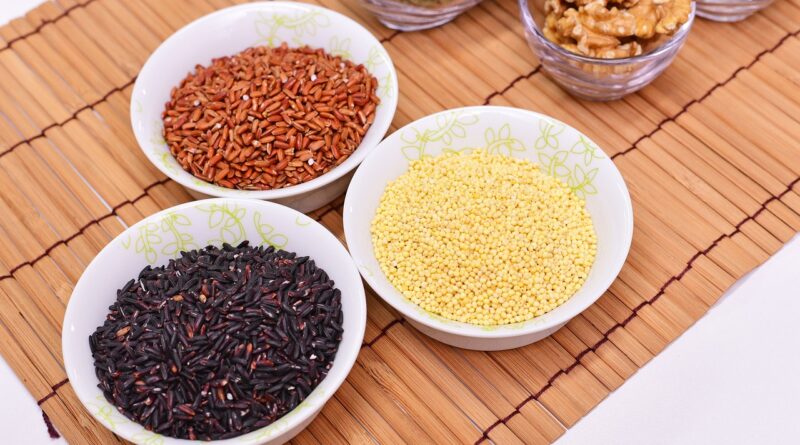Power of Millets: Top Millet Foods and Their Health Benefits in India
In recent years, millets have made a significant comeback in India’s kitchens, offering a healthy, sustainable, and nutrient-packed alternative to rice and wheat. Known as ancient grains, millets have been part of India’s culinary heritage for centuries, but it’s only recently that their immense health benefits have come into the spotlight. This article explores the best millet foods available in India and their associated health benefits, showing why these superfoods are essential to a balanced diet.
What Are Millets? A Quick Overview
Millets are small-seeded grasses, cultivated for food and fodder for over 10,000 years in Asia and Africa. They are resistant to harsh climates, require minimal water, and grow on arid, nutrient-poor soils. This makes them highly sustainable, helping address food security and environmental challenges in regions where traditional crops struggle.
In India, millets are often referred to as “Siri Dhanya” or “miracle grains.” The popular types include Ragi (Finger Millet), Jowar (Sorghum), Bajra (Pearl Millet), and Foxtail Millet, each offering unique health benefits. Let’s dive into these superfoods and explore why they’re becoming a staple in modern, health-conscious diets.
Top Millets in India and Their Health Benefits
1. Ragi (Finger Millet)
Benefits:
Rich in Calcium: Ragi is an excellent source of calcium, promoting bone strength, particularly important for children, pregnant women, and elderly individuals who need to maintain bone density.
High in Fiber: The fiber content in Ragi supports digestion, helps reduce blood cholesterol levels, and manages blood sugar, making it suitable for diabetics.
Aids Weight Loss: Due to its fiber content, Ragi keeps you full for longer, reducing cravings and aiding in weight management.
Antioxidant Powerhouse: Ragi contains polyphenols, which help fight oxidative stress, reduce inflammation, and improve immunity.
Popular Foods Made with Ragi:
Ragi Mudde: A Karnataka staple made by steaming Ragi flour into dough balls.
Ragi Dosa: A healthier variant of dosa made with Ragi flour.
Ragi Porridge: A nutritious breakfast choice, ideal for kids and elders.
2. Jowar (Sorghum)
Benefits:
Essential Fruits and Vegetables to Eat During Winter in India for Optimal Health
Gluten-Free Grain: Jowar is naturally gluten-free, making it suitable for individuals with gluten intolerance or celiac disease.
Supports Heart Health: Jowar’s high fiber content lowers cholesterol levels and reduces the risk of heart disease.
Improves Digestive Health: The fiber in Jowar promotes a healthy gut, prevents constipation, and aids in detoxification.
Packed with Antioxidants: It contains tannins, anthocyanins, and other antioxidants that combat inflammation, oxidative stress, and even cancer.
Popular Foods Made with Jowar:
Jowar Roti: A soft, gluten-free roti popular in Maharashtra and Karnataka.
Jowar Porridge: A nutritious breakfast or dinner option with various flavoring options.
Jowar Upma: A twist on the traditional upma, made with Jowar for added nutrition.
3. Bajra (Pearl Millet)
Benefits:
Heart-Friendly Grain: Bajra contains magnesium, which is crucial for heart health, regulating blood pressure, and preventing cardiovascular disease.
Boosts Immunity: Rich in iron, zinc, and other minerals, Bajra boosts the immune system, aiding in wound healing and preventing anemia.
Aids Digestion: Bajra’s high fiber content promotes smooth digestion and prevents issues like bloating and constipation.
Thermogenic Properties: Bajra is known to have warming properties, making it ideal for consumption during winter as it helps maintain body warmth.
Popular Foods Made with Bajra:
Bajra Roti: A traditional flatbread popular in Rajasthan and Gujarat, often enjoyed with a side of buttermilk.
Bajra Khichdi: A one-pot meal with Bajra, vegetables, and spices.
Bajra Ladoo: A healthy, energy-rich dessert often made during winter.
4. Foxtail Millet
Benefits:
High Protein Content: Foxtail millet is packed with proteins, essential for muscle building and repair.
Low Glycemic Index: Ideal for diabetics, as it releases sugar gradually into the bloodstream, avoiding spikes in blood glucose levels.
Rich in Vitamins and Minerals: It is a good source of iron, calcium, and B vitamins, essential for maintaining energy levels and cognitive health.
Promotes Heart Health: The antioxidants in Foxtail millet reduce the risk of heart diseases and hypertension.
Popular Foods Made with Foxtail Millet:
Foxtail Millet Upma: A delicious and nutritious breakfast or dinner option.
Foxtail Millet Pongal: A variation of the traditional South Indian Pongal made with Foxtail millet.
Foxtail Millet Salad: A refreshing, fiber-rich salad made with cooked Foxtail millet and fresh vegetables.
5. Kodo Millet
Benefits:
Anti-Diabetic Properties: Kodo millet has a low glycemic index, which helps maintain stable blood sugar levels and is especially beneficial for diabetics.
Rich in Phosphorus: It promotes bone health and cellular repair.
Supports Weight Loss: With its high fiber content, Kodo millet keeps you satiated for longer, reducing overeating and aiding in weight management.
Improves Nervous System Health: Kodo millet contains essential B vitamins that support nerve health and reduce anxiety and stress.
Popular Foods Made with Kodo Millet:
Kodo Millet Khichdi: A nutritious one-pot meal with vegetables and spices.
Kodo Millet Dosa: A healthier twist on the regular dosa, made with Kodo millet flour.
Kodo Millet Pulao: A flavorful pulao made with Kodo millet, packed with vegetables and spices.
Additional Health Benefits of Millets
Millets offer a broad spectrum of health benefits, making them an excellent addition to any diet:
Rich in Nutrients: Millets contain essential vitamins (like B-complex vitamins), minerals (such as magnesium, iron, and zinc), and antioxidants, making them a powerhouse of nutrients.
Improves Metabolism: The high fiber content in millets aids digestion, stabilizes blood sugar levels, and supports metabolism.
Eco-Friendly Grain: Millets require less water to grow, making them a sustainable and eco-friendly crop, essential for reducing the water footprint and supporting biodiversity.
Best Diet Foods in India for Weight Loss: A Guide to Healthy and Sustainable Eating
Bone Health: Millets like Ragi, packed with calcium, promote bone health, which is crucial for children, athletes, and older adults.
How to Incorporate Millets into Your Daily Diet
Adding millets to your daily diet is easier than it might seem. Here are some ideas to get you started:
Breakfast Bowls: Replace oats or rice with millet grains like Ragi or Foxtail for a nutritious breakfast porridge.
Smoothies: Add a tablespoon of Ragi flour to your morning smoothie for an extra calcium boost.
Salads: Use cooked millets as a base for hearty salads, adding in vegetables, nuts, and seeds for flavor and texture.
Millet Dosa or Idli: Substitute rice with millets in traditional South Indian breakfast foods like dosa or idli for a healthier twist.
Khichdi and Pulao: Use millets instead of rice for khichdi and pulao, packing in more nutrients and fiber.
Conclusion: The Millet Revolution in India
The resurgence of millets in India is not just a trend but a shift towards a healthier, more sustainable lifestyle. With their nutrient density, versatility, and numerous health benefits, millets are a perfect fit for modern diets. From Ragi and Jowar to Bajra and Foxtail millet, these grains are ideal for improving digestion, heart health, and overall wellness.
Embracing millet foods in daily meals supports personal health while contributing to environmental sustainability and the revival of traditional grains. Whether you’re looking to manage your weight, control blood sugar, or simply enhance your nutrition, incorporating millets into your diet is a small change with a big impact.




